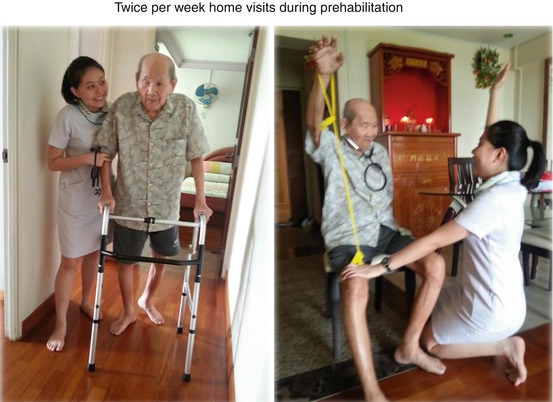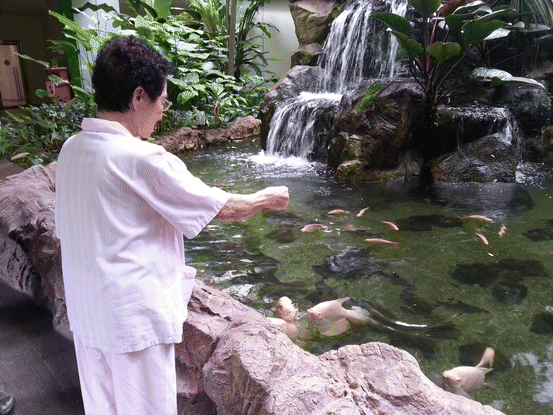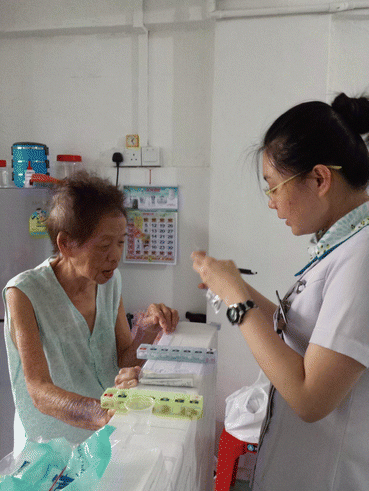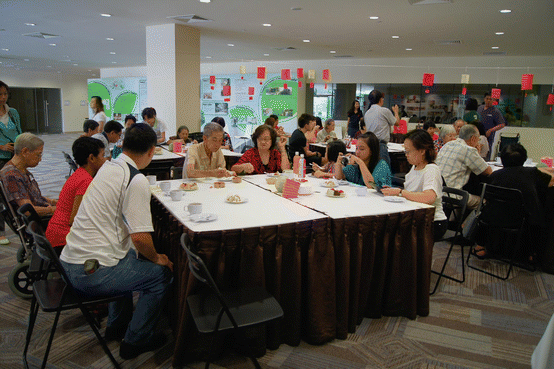Fig. 2.1
Khoo Teck Puat Hospital Transdisciplinary Geriatric Surgery Team
2.2.1.1 Patient Involvement in the Team
In this model, the patient is actively involved in the entire process. The patient is actively educated through multimedia tools on the pathology of their disease. This is followed by a stepwise consenting process for the proposed surgical procedure. Options for other viable options are discussed in a team-based fashion. The patient is then engaged actively in the process of prehabilitation (Fig. 2.2) and, after the operation, is empowered to perform activities of living early and also with the process of rehabilitation (Fig. 2.3). The patient is considered an essential component of the team. Through processes of education and engagement, compliance with the care plan is heightened.



Fig. 2.2
Patient involvement and active engagement in the prehabilitation process before surgery

Fig. 2.3
Patient 4 days after surgery being empowered to go to our gardens to feed the fishes as part of the process of building confidence to return home for independent living
2.2.1.2 Early Goal-Setting Identifiable to the Team
This component involved the identification of the key goals for the treatment of the patient. These goals are identifiable to the patient and family members and also to the entire team. These goals have to be individualised to the patient and should not be forced on the patient. Team members may discuss about the validity of these goals at initial assessment but have to be aligned once there is consensus.
2.2.1.3 Enhanced Coordination
The coordination of care is crucial to the delivery of seamless care to surgical patients. As such, the nurse clinicians on the team play a central role in providing oversight of the total care of each patient. Input from each element of the team is tracked by the coordinating nurse, and at the same time, targets are set with regard to the timing within which the intervention is to be performed. Patients who need to undergo prehabilitation have target milestones set and the date for surgery set. This is followed by coordination of inputs from the dietitian and physiotherapist not only in the inpatient setting but also in the outpatient setting and in patients’ homes (Fig. 2.4).


Fig. 2.4
Home visits to help patients stay compliant to treatment strategies and medications
Completed interventions are documented such that other members of the team are aware.
2.2.1.4 Heightened Communication
This is performed through formal meetings, frequent ad hoc discussions among team members, communications sheets in the case notes and the use of multimedia technology. Although this heightened communication is useful in the enhancement of care, patient confidentiality cannot be compromised and measures are put in place to ensure that this standard is upheld.
2.2.1.5 Role Enhancements
The enhancement of the roles of the individuals in this team-based care in the implementation of transdisciplinary care includes role extension, role enrichment, role expansion, role release and role support. Role extension demands a constant learning attitude towards attaining knowledge of one’s discipline and in doing so become secure with one’s own role in the system. This is followed by role enrichment which involves acquiring knowledge and understanding of other disciplines and then role expansion as one then starts to educate other members of the team about one’s own expertise. Only with these can role release and support occur, breaking the boundaries of traditional disciplines, and individuals can then exert an effect in a transdisciplinary fashion.
2.2.1.6 Start to Finish
The team’s involvement in the surgical patient is from start to finish. The same individuals are present at the initial diagnosis and assessment, follow through consenting and prehabilitation, see the patient through surgery and are there for the rehabilitation, tackling problems with the patient as they arise. Care does not stop with discharge but continues into outpatients and the community (Fig. 2.5). Only through this process can the team truly build rapport with the patient and truly understand the difficulties faced by the patient during this whole process.


Fig. 2.5
Gathering of postsurgical patients to ensure that they continue to have the ability for independence and social integration
2.3 Integrative Decision-Making and Care Planning for Elderly Surgical Patients
Integrative care of an elderly surgical patient starts with proper surgical decision-making. The decision-making process is team-based and stepwise. It is critical to understand that decision-making in these elderly patients needs to take into full consideration the goals and concerns of the patient. Thus, engagement of the patient into this decision-making process through education and consultation on management approach is vital. In a recent study on the type of information patients desired before undergoing visceral surgery, more than 64 % of patients were keen to participate in medical decision-making with regard to management of surgical complications and management in the intensive care unit (Uldry et al. 2013). It is not appropriate to concentrate on the immediate perioperative period as 30-day mortality and morbidity may not clearly define good outcomes for elderly surgical patients. Functional recovery and independence are likely more important (Chee and Tan 2010). Furthermore another recent study from the Netherlands warned that a significant number of patients die within a year after curative colorectal surgery, and this data should impact our decisions in offering surgery (Gooiker et al. 2012).
The team should take into consideration clinical findings including co-morbidity index and frailty, together with aspects of nutrition, functional status and psychosocial problems in the decision-making process. These can only be assessed through a team-based approach with different members of the team providing expertise in the assessment process. A more holistic picture of the patient can then be painted to aid in the decision-making process. The integration of geriatric assessment techniques have been shown to improve perioperative outcomes (Cheema et al. 2011).

Full access? Get Clinical Tree








